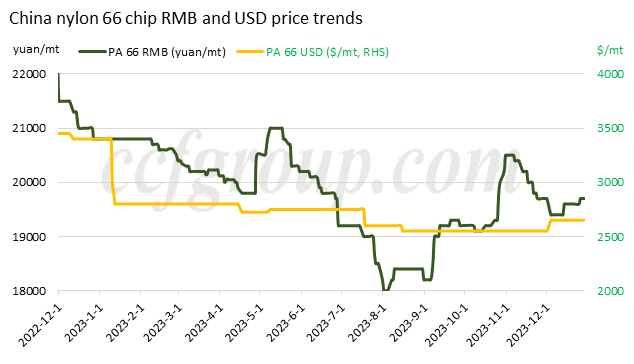Nylon 66 market feels rising pressure
In December, the overall performance of PA66 was stable with slight fluctuations. From the market mentality, the expectation of weakening demand in December and January dominated the market trading, which was also in line with expectations. Downstream demand was slightly differentiated, with steady orders for polymerization plants. However, due to the low-priced market supply, negotiations with manufacturers were still difficult. As a result, prices remained low early in the month, mainly due to some profit-taking sales were still not ended, while raw material suppliers such as Yangnong Ruitai and Invista have gradually restarted their HMDA production, with the bullish momentum largely exhausted. In addition, adipic acid remained low with no signs of largely rebounding.
In terms of polymer supply, Huafon started up a 60kt/year nylon 66 chip production line at the end of November, while Shenma plans to commence a new 40kt/year capacity in the near term, with supply expectations tilted towards being inadequate. In addition, some traders holding low-cost inventory are reducing their prices before the Spring Festival, resulting in a decline in market prices.

However, from the perspective of polymerization, it is difficult to offset the rising cost of HMDA, so new negotiations between new orders and market bulk transaction are of a price differential of 800-1,000yuan/mt in the first half of the month, possibly even higher. This puts significant pressure on polymerization plants and may result in a portion of high-cost inventory being built up in December.
Taking into account the fact that lower-priced market supply will start to clear in the middle and late part of the month, and that under the uncertain outlook for adipic acid prices in January, polymerization plants will not relax their price negotiations, overall the sliced market prices will rebound. However, the downstream picking-up pace has also slowed down, with increased inventory pressure on some polymerization plants. By the end of the month, the adipic acid price has landed, and with the expectation of stable sliced market conditions, downstream replenishment began to increase.
Looking ahead to the expectation before and after the Spring Festival, the demand for modified plastic will seasonally taper off, especially for some small factories that have essentially begun to wrap up their work and the operating rate will be significantly lower than December. However, considering the post-holiday stocking plans, the actual purchasing volume will not be significantly reduced. The industrial filament market began to decline significantly in November, but the production and sales situation improved slightly in December, with some production reduction expected in January and February. Therefore, the loss on the polymerization side in January and February should be relatively obvious. In order to maintain production during the Spring Festival, polymerization plants will control their operating rate and adjust their inventory in January, and some may accept lower prices to ensure a high operating rate during the Spring Festival.
In addition, it is expected that adipic acid market may remain stable and fluctuating at lows. The major suppliers of adipic acid, Invista and Huafon, are also unlikely to suppress chip market prices by lowering raw material prices in January and February. Therefore, the cost support for chip in January and February is expected to remain relatively strong, and if the supply and demand structure remains unfavorable, polymerization plants will appropriately reduce production and accept orders with lower prices, and chip prices may remain under pressure.
- Top keywords
- Cotton Price
- Cotton Futures Price
- Cotton Futures
- CZCE
- PTA Futures Price
- Chemical Fiber
- Polyester Prices
- Wool price
- PTA Futures
- Shengze Silk
- China
- Yarn Price
- price
- China Textile City
- Fibre Price
- Benzene Price
- Cotton
- Index
- Cotton Index
- PTA
- fabric price
- NYMEX
- Top 10
- textile industry
- Spot Cotton
- Cotton Yarn
- Polyester Price
- Futures
- PTA Price
- cotton yarn price

